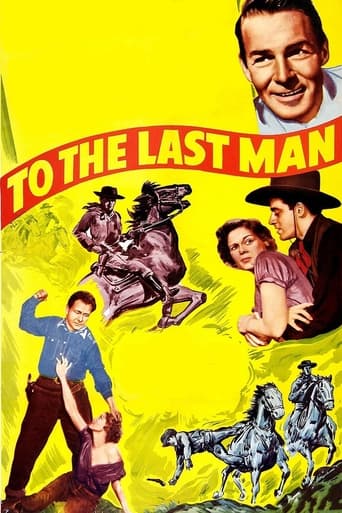JohnHowardReid
The first thing that strikes a current audience is the way the characters are introduced, silent film style. An interesting idea, but you can see why it went out of fashion as it interrupts the flow of the narrative. We're well into the movie before Randolph Scott finally appears and it's a bit disconcerting to suddenly have a sub-title superimposed, "Randolph Scott... Lynn Hayden."The next arresting thing is undoubtedly the fact that in some scenes Hathaway keeps his camera jumping around in a fascinatingly imaginative fashion, taking full advantage of the breadth of the sets and the width of the great outdoors. Pace is further enhanced by breaking up many of the scenes into (by modern standards) an unusually large variety of camera angles (leading to some rough editing in places).The lighting by Ben Reynolds also dates the picture on at least two fronts as it's unfashionable to use soft focus anymore; and illuminating night scenes with only a little key light and little or no background fillers at all has been a definite no-no ever since picturegoers complained that they paid money to see their favorite stars at full strength not half-hidden by shadows.For all Hathaway's efforts to quicken the pace, his players tend to work against him, not only by speaking slowly but by inserting long pauses between words, phrases, and especially cues. Oddly enough, the villains are the worst offenders. In fact this film reverses the general Hollywood rule and makes the goodies much more interesting and diverting than the baddies. Noah Beery and his bunch are not only dull and cliched but abnormally colorless. Hammy acting from Noah Beery and Jack LaRue doesn't help. Not that the good guys are innocent of theatrics, but Scott gives such a likeable and personable performance, he makes up a lot of the leeway. As for the once super-popular star Esther Ralston we can understand why her fortunes declined in the talkies. Her voice is okay but it not only doesn't jibe with the character, she's unable to use it expressively. All her emotions are still registered through her eyes, her facial muscles, her body language. Some of the support players are so bland or so impersonal or so amateurish it's hard to credit they managed to carve out considerable careers in the years ahead: Buster Crabbe, Gail Patrick, Barton MacLane, Fuzzy Knight. Plus Beery and LaRue. As for Miss Temple, well she was only five years old at the time and she does reasonably and recognizably well by her small part. It's the abominable Watson brat who has the lion's share of the kiddie footage.Hathaway's taste for violent action (the principals fight without doubles) and his penchant for location shooting are well in evidence throughout, though the long-awaited climax is a bit abrupt and resolved in a somewhat unsatisfying fashion, but these structural faults doubtless derive from the Zane Grey novel. Incidentally, despite reports to the contrary, there are only five or six short snips of stock footage, few of which seem to have been lifted from the original 1923 picture which has quite different emphases in its storyline.
Syl
This movie is in the Shirley Temple collection. She is only in a for a few minutes and uncredited. The film was under the title, Law of Vengeance, instead of the Last Man. It must have been her film debut. The film is dark in subject matter as there is plenty of violence. The cast is excellent with Randolph Scott and Esther Ralston and others. The film shows the dangers of gun violence and vengeance between warring families in the Wild West. In 1933, the film industry was just getting started. I feel though this film was misplaced in the collection. The ending appeared abrupt and left in doubt about the ending too!
MartinHafer
"To the Last Man" is an interesting film--partly because of a couple uncredited performances and partly because it is a very gritty sort of film. As far as the uncredited roles go, you'll see Shirley Temple just before she became a mega-star as well as a tiny appearance by John Carradine.The film begins just after the Civil War. As a man returns to his wife in the hills of Kentucky, you see his father-in-law being murdered by a neighbor. The killing is all part of a long-standing feud (like the infamous Hatfield and McCoy feud) but instead of killing the perpetrator, the war vet has announced he's seen enough killing and takes the case to court. His family at first is upset he didn't kill the killer, but in the long run it was the logical thing to do. However, the murderer is NOT logical and vows to renew the feud after his 15 year sentence is complete. Now this guy is super-serious--and even after his enemy leaves Kentucky and moves to Nevada, he and his clan move west just so they can get their revenge!! But, instead of just shooting them, the ex-con plans on ruining their ranch--with the help of his best prison buddy. However, there is a monkey wrench in this plan--his daughter is about to fall in love with one of the enemy (Randolph Scott)! How's all this insanity going to end?! While the plot isn't all that remarkable, the film works because the film is very gritty and unsentimental. You'll see a lot of Pre-Code style violence--and this actually helps the film to be both realistic and creates a strong impact--especially during the big showdown at the end. Bold and gritty--and worth seeing.
John Seal
This tale of fussin' and a feudin' is showing its age in spades, but at least it benefits from a memorable cast: Randolph Scott, Buster Crabbe, John Carradine, and little Shirley Temple, whose doll gets its head shot off. Jack La Rue plays the villain and is in desperate need of a moustache to twirl.


